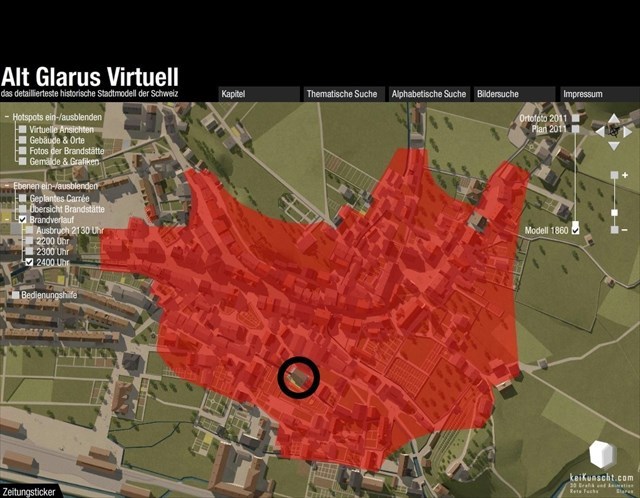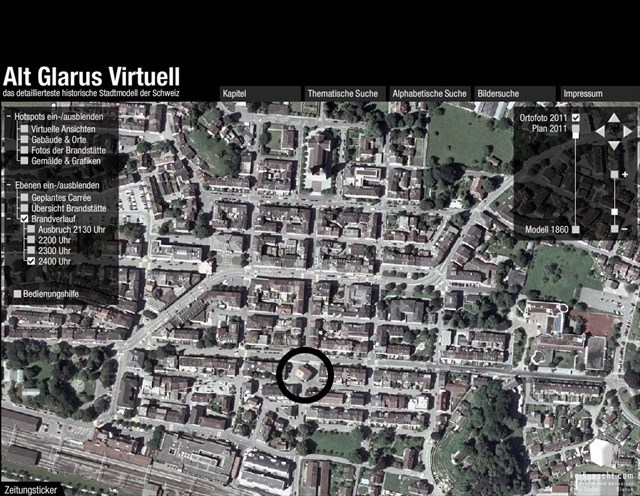Die Koordinaten führen euch zu einem Haus, welches aus dem Schachbrettmuster tanzt!
The coordinates will guide you to a house which withstands the checkerboard pattern! (english below!)
Der Brand von Glarus in der Nacht vom 10. auf den 11. Mai 1861 gehörte zu den grössten Brandkatastrophen des 19. Jahrhunderts in der Schweiz. Zwei Drittel des Kantonshauptortes Glarus wurden dabei zerstört, die Hälfte (47%) der Einwohner wurden obdachlos.
Auszug aus Alt Glarus Virtuell:
Stampf, Erbaut 1839
«Stampf» bezeichnet die Vorrichtung zum Zerkleinern oder eben Zerstampfen von Baumrinde zur Herstellung von Gerberlohe. Eine solche Stampfe und eine Sägerei sind hier bereits für das 16. Jahrhundert nachgewiesen, Energielieferant war der Giessen. Ab 1839 wurde der südliche Teil des noch bestehenden Gebäudes als Textildruckerei genutzt. 1859 kam der Stampf in die Hände der Familie Heer. Dank des nahen Giessens und der Schwändener Feuerwehr überstand der Stampf den Brand und wurde als ein Brand-Denkmal in den neuen Stadtplan integriert.
1861: Brandverlauf um 24:00 (nach nur 2.5h) | 2011: Der Stampf mitten im Schachbrettmuster....


Auszug aus Wikipedia:
Das Feuer brach nach halb zehn Uhr abends in einer Scheune neben dem Haus von Ratsherr Christoph Tschudi auf dem Landsgemeindeplatz aus und breitete sich wegen des Föhns schnell Richtung Norden aus. Der Widerschein der Feuersbrunst war westwärts in Basel und auf den Jurahöhen, ostwärts bis weit über den Bodensee hinaus in Ravensburg und Ulm zu beobachten.
Die meisten Bewohner waren noch wach, als das Feuer ausbrach, und konnten sich retten. In der Brandnacht kamen zirka acht bis zehn Personen ums Leben, doch starben einige noch später an den Folgen von Brandvergiftungen. Die genaue Zahl der Todesopfer ist unbekannt. Zu diesen gehörte auch Kriminalgerichtspräsident und Nationalrat Johannes Trümpi mit seiner Familie. Die Brandkatastrophe wurde zum Medienereignis. Die grossen Zeitungen selbst im Ausland berichteten darüber.
Der Brand von Glarus löste eine starke Solidaritätswelle aus. Die Spendenaktion war die erste im 1848 gegründeten Bundesstaat und sozusagen der Vorläufer der heutigen Glückskette. Tausende von Privaten und Vereinen spendeten ebenso wie Gemeinden und Kantone für die Brandgeschädigten in Glarus. Tonnenweise wurden Hilfsgüter wie Lebensmittel, Decken und Kleider mit der zwei Jahre vorher in Betrieb genommenen Eisenbahn an den Unglücksort geliefert. Die Geldspenden erreichten die damalige Rekordsumme von 2.7 Millionen Franken. Damit konnte ein Teil des Gesamtschadens von zehn Millionen Franken gedeckt werden.
Glarus wurde in nur drei Jahren wieder aufgebaut. Die Pläne für den Wiederaufbau stammten von Architekt Bernhard Simon (1816–1900) und dem Zürcher Staatsbauinspektor Johann Kaspar Wolff (1818–1891). Typisch für das neue Glarus ist die schachbrettartige Architektur mit breiten, langgezogenen Strassen und stattlichen Amtshäusern. Vorbilder waren etwa das 1794 abgebrannte La Chaux-de-Fonds oder Städte wie New York oder St. Petersburg. Auf dem Gebiet der Feuerpolizei leistete Glarus nach der Brandkatastrophe Pionierarbeit. Das Verbot der mit Holzschindeln beschlagenen Häuser wurde strikt durchgesetzt. Diese mussten mit feuersicherem Material ausgerüstet sein. Holzbauten wurden im Ortskern verboten.
Die Ursache des Brandes wurde nie geklärt.
LOG BEDINGUNG:
Gehe an den in den Koordinaten angegebenen Ort und mache ein Foto vom quer stehenden Haus. Wähle selbst einen Blickwinkel von dem man den Querstand des Stampf (Haus) erkennen kann. Wenn du willst, kannst du ein Selfie oder auch deine Cachingutensilien mit auf das Bild nehmen.
Eine Drohnen-Aufnahme wäre natürlich MEGA-Cool!...
Hänge dieses Bild an deinen Log  oder sende es mir über mein Profil 😉
oder sende es mir über mein Profil 😉
Logeinträge ohne Beweis-Bild, werde ich kommentarlos löschen! 
 Klosi1
Klosi1
_______________________________________________________________
ENGLISH:
The fire of Glarus in the night of 10 to 11 May 1861 was one of the largest fire disasters of the 19th century in Switzerland. Two-thirds of the canton's capital Glarus were destroyed, half (47%) of the population were homeless.
Excerpt from Alt Glarus Virtual:
Stampf, built in 1839
"Stampf" refers to the device for crushing tree bark for the production of tanbark. Such a pestle and a sawmill are here already proven for the 16th century, Energy supplier was the "Giessen". From 1839, the southern part of the still existing building was used as a textile printing company. In 1859 the Stampf came into the hands of the Heer family. Thanks to the nearby "Giessen" and the Schwandser fire brigade the Stampf survived the fire and was integrated as a fire monument in the new city plan.
1861: Fire at 24:00 (after only 2.5h) | 2011: The Stampf in the midst of the checkerboard pattern ...


Excerpt from Wikipedia:
The fire broke out at half past nine in a barn next to the house of councilor Christoph Tschudi on the Landsgemeindeplatz and spread fast north because of the hot dry wind. The reflection of the conflagration could be observed westwards in Basel and on the Jura hills, eastwards to far beyond Lake Constance in Ravensburg and Ulm.
Most of the residents were still awake when the fire broke out and were able to save themselves. On the night of the fire, about eight to ten people were killed, but some later died as a result of fire poisoning. The exact death toll is unknown. To these belonged also Kriminalgerichtspräsident and Nationalrat Johannes Trümpi with his family. The fire catastrophe became a media event. The big newspapers themselves abroad reported about it.
The fire of Glarus triggered a strong wave of solidarity. The fundraiser was the first federal state founded in 1848 and, so to speak, the forerunner of today's Swiss Solidarity. Thousands of private individuals and associations, as well as communities and cantons, donated to the burnt victims in Glarus. Tons of relief supplies such as groceries, blankets, and clothes were delivered to the site of the accident with the two-year-old railroad. The donations reached the then record amount of 2.7 million francs. This covered part of the total damage of ten million francs.
Glarus was rebuilt in just three years. The plans for the reconstruction came from architect Bernhard Simon (1816-1900) and the Zurich state building inspector Johann Kaspar Wolff (1818-1891). Typical of the new Glarus is the checkered architecture with wide, elongated streets and stately office buildings. Examples were the 1794 burned La Chaux-de-Fonds or cities such as New York or St. Petersburg. In the field of fire police Glarus made pioneer work after the fire catastrophe. The ban on wooden shingles studded houses was strictly enforced. These had to be equipped with fire-proof material. Wooden buildings were banned in the center.
The cause of the fire was never clarified.
LOG CONDITION:
Go to the location indicated in the coordinates and take a picture of the crooked house. Choose yourself a viewpoint from which one can recognize the obliquity of the Stampf (House). If you want, you can take a selfie or your caching utensils on the picture.
A drone recording would of course be MEGA-Cool! ...
Attach this picture to your log  or send it direktly to me over my profile 😉
or send it direktly to me over my profile 😉
Log entries without proof image, I will delete without comment! 
 Klosi1
Klosi1
_____________________________________________________________
Virtual Rewards 2.0 - 2019/2020
This Virtual Cache is part of a limited release of Virtuals created between June 4, 2019 and June 4, 2020. Only 4,000 cache owners were given the opportunity to hide a Virtual Cache. Learn more about Virtual Rewards 2.0 on the Geocaching Blog.